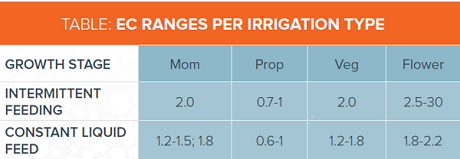After prolonged fertigation or overfeeding at too-high concentrations, nutrients can build up in the growing substrate and cause plants to refuse nutrition. The effect is similar to that of imbalanced pH: nutrient antagonism.
Electrical Conductivity (EC) is an important concept to remember, because it gives a macro view of the number of salts in your growing media. Regular measuring the EC and pH of a plant’s root zone with the Pour Thru Method (as described below) will help you make informed corrections to your fertigation strategy.
Essentially, the Pour Thru Method entails collecting runoff, called leachate, from the growing media and measuring its EC and pH.
- Saturate the growing media: Choose several plants from each growing area. Add irrigation until the growing media is saturated. Then, wait 30-45 minutes so that the solution can homogenize across the entire media.
- Add water to the growing media: Place a deep saucer under the pot and add distilled water. Depending on the pot size 200-500 mL (7-10 fl oz) will be necessary to saturate the growing media.
- Collect the leachate: Ideally, 50mL of leachate will pour through the growing media, but 100 mL will also produce an accurate reading. Transfer the solution to a cup deep enough to submerge the probes of the pH/EC meter.
- Measure and analyze the leachate: Your properly calibrated meter will display the pH and EC values. At this time, you can measure how the leachate from the root zone compares to your fertilizer. Refer to the table below for general guidelines on EC.
- Keep records: make sure to record your leachate testing and fertilizer EC. Entering the data into a spreadsheet makes graphing your results easy. This information helps you better understand your plants needs and how the metabolisms of your chosen cultivars compare to one another.

Working with a Laboratory
It is important to note that a pH/EC meter cannot tell the whole story of your crop’s nutrition or chemical composition. When cultivating at a commercial scale, laboratories can provide reports of every macro- and micronutrient in your fertilizer solution, growing media, and biomass. While it may seem curious to test the chemical composition of a plants’ biomass, understanding exactly how nutrients are absorbed and translocated in the plant — from the bottom leaves to the top — may affect future fertilization choices and is an informed way to make adjustments to your fertigation strategy.
Further, detailed information from laboratories may affect how you cultivate and feed different cultivars. Another resource to check, is a local state university’s horticultural extension department. Many universities can provide these types of testing services or may be able to point you to a reliable alternative.
For more information:
Fluence Bioengineering
4129 Commercial Center Drive
Suite 450
Austin, TX 78744
512-212-4544
info@fluencebioengineering.com
fluence.science
